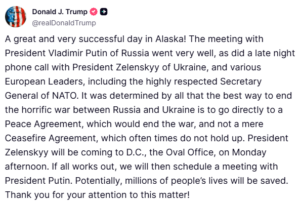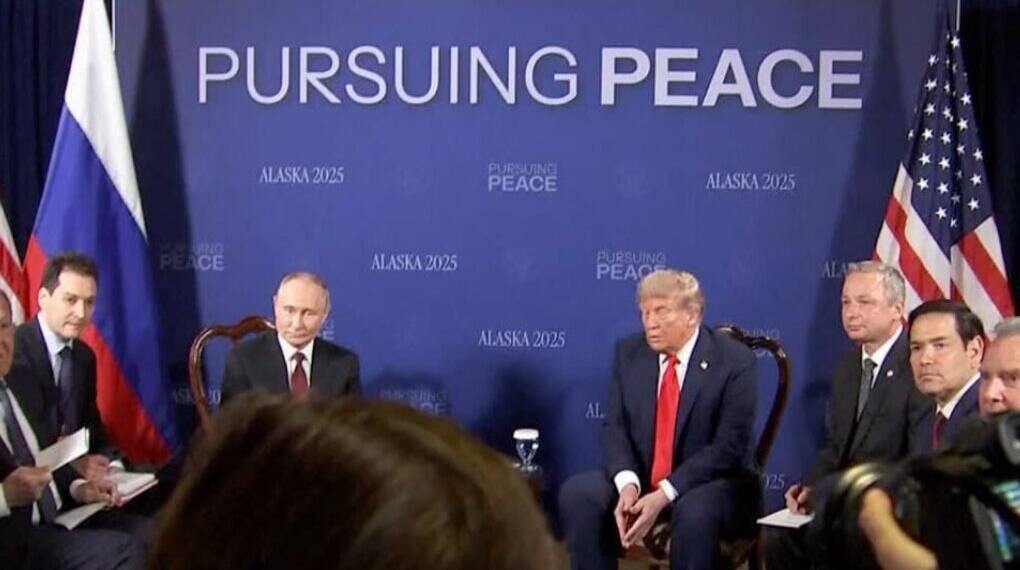U.S. President Donald Trump held a high-level call with Ukrainian President Volodymyr Zelenskiy and several European leaders on Saturday, briefing them on his much-anticipated meeting with Russian President Vladimir Putin in Alaska.

The conversation, which lasted more than an hour, comes amid growing speculation over a potential breakthrough in efforts to end the war in Ukraine, now stretching into its fourth year.
Trump, speaking from Air Force One, described his talks with Putin as “productive,” though he admitted that a final pathway toward peace had not yet been reached. According to officials familiar with the call, the U.S. president sought to rally European and Ukrainian leaders behind the idea of a direct trilateral summit between himself, Putin, and Zelenskiy in hopes of accelerating negotiations.
European Reaction: Cautious Support, Underlying Concerns
European leaders welcomed Trump’s diplomatic push but emphasized that decisions regarding Ukraine’s territory must rest solely with Kyiv. They reiterated that any talks should begin from the existing line of contact on the battlefield, which remains contested. Several officials, however, expressed concern that Trump could pressure Ukraine into territorial concessions to quickly secure a deal.
“We reaffirmed that Kyiv must receive strong and reliable security guarantees to make any peace settlement sustainable,” one European diplomat said. “Military and financial support for Ukraine will continue, regardless of the pace of negotiations.”
While European governments cautiously endorsed Trump’s initiative, Russia signaled a different tone. State TV network Vesti quoted Kremlin aide Yuri Ushakov as saying that no discussions had taken place about a trilateral summit involving Putin, Trump, and Zelenskiy.
Zelenskiy: Ukraine Ready for “Maximum Effort” Toward Peace
In a statement following the call, President Zelenskiy said Ukraine remained committed to seeking peace but stressed that it must be achieved with full involvement of its allies.
“We had a long and substantive conversation with President Trump. Our call lasted more than an hour and a half, including about an hour of bilateral discussion,” Zelenskiy said. “Ukraine reaffirms its readiness to work with maximum effort to achieve peace. America’s strength must have an impact on the development of the situation.”
Zelenskiy also welcomed Trump’s proposal for a trilateral meeting, saying key issues should be addressed directly at the leaders’ level. He underscored the need for Europeans to remain engaged throughout the process, particularly in guaranteeing Ukraine’s security.
On Monday, Zelenskiy is scheduled to meet Trump in Washington, D.C., where the two are expected to go deeper into the details of what Kyiv has called a “realistic pathway” toward ending the war.
Trump’s Messaging: Urgency for a Direct Deal
Speaking to Fox News’ Sean Hannity after his Alaska meeting with Putin, Trump described the day as “great and very successful,” but admitted that “a few sticking points” remained. He suggested that the best course might be to bypass a temporary ceasefire and aim directly for a long-term peace agreement.
“It’s really up to President Zelenskiy to resolve this,” Trump said, signaling that the Ukrainian leader’s choices in the coming days will be critical to determining whether talks succeed.
What next?
The flurry of diplomacy underscores the high stakes of the moment. Trump’s direct engagement with both Putin and Zelenskiy marks the most significant U.S. intervention in the conflict since the war began. For Kyiv, the challenge remains securing a peace that does not compromise sovereignty or territorial integrity, while for Washington, the priority is to demonstrate progress on a war that has reshaped global security and strained Western alliances.
Whether a trilateral summit will materialize remains uncertain. For now, Ukraine is preparing to put forward its demands in Washington on Monday, with European allies watching closely and the Kremlin withholding public commitments.
The coming week could prove decisive in determining whether the Alaska meeting opens a genuine path toward ending one of Europe’s bloodiest wars in decades.








